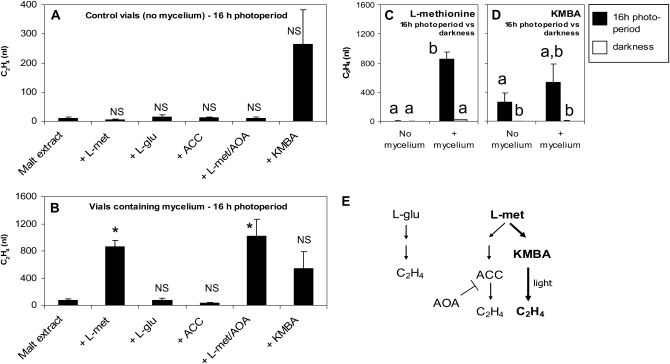Figure 4.
Ethylene biosynthesis in truffles. The occurrence of three ethylene biosynthesis pathways described in microorganisms was investigated in T. borchii using various ethylene precursors/inhibitor. Under 16-h photoperiods and without mycelium, addition of the ethylene precursor/inhibitors to malt extract did not significantly increase ethylene concentration (A). Under 16-h photoperiods, significantly higher ethylene levels were detected from mycelium grown on l-Met compared to the mycelium grown on unsupplemented medium (B). The other ethylene precursors (l-Gln, ACC, KMBA) did not increase the ethylene concentration compared to the mycelium grown on unsupplemented medium (B). Addition of AOA, an inhibitor of the ACC pathway, did not reduce ethylene concentration, confirming that l-Met was not transformed through the ACC pathway (B). The mycelium could only transform l-Met to ethylene under 16-h photoperiods, but not in the dark (C). In the contrary, KMBA was photodegraded to ethylene regardless of the presence/absence of the mycelium, while the molecule was not degraded in the dark (D). Taken together, these results demonstrate that ethylene is synthesized from l-Met probably through the KMBA pathway (marked in bold in E). Statistics: P < 0.05, Mann-Whitney. For A and B, asterisk (*) indicates difference from the unsupplemented malt extract; NS = nonsignificant. For C and D, different letters indicate statistically different results. For each treatment, n ≥ 3. Bars = ses (A–D).

